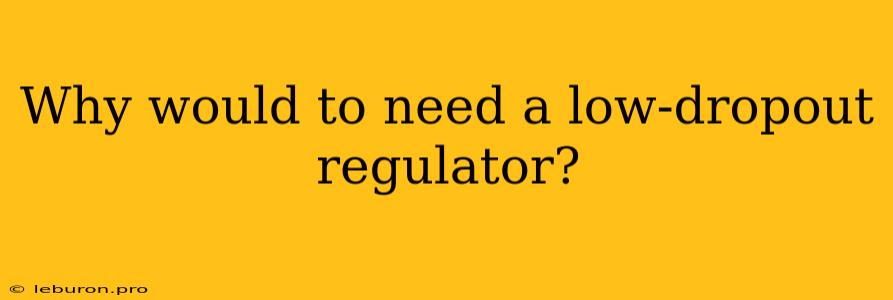In the realm of electronic circuits, power supply design plays a crucial role in ensuring the smooth and reliable operation of devices. A critical component within this realm is the voltage regulator, responsible for maintaining a stable and consistent output voltage despite fluctuations in the input voltage or load conditions. Among the various types of voltage regulators, low-dropout regulators (LDOs) stand out as a popular choice for applications requiring high efficiency, low noise, and minimal voltage drop. This article will delve into the reasons why you might need a low-dropout regulator, exploring its advantages, key characteristics, and common applications.
Understanding Low-Dropout Regulators (LDOs)
Low-dropout regulators are linear voltage regulators designed to operate with a very small voltage difference, or "dropout voltage," between the input and output. This low dropout voltage characteristic makes them ideal for applications where input voltage is limited or where a high degree of efficiency is paramount.
Advantages of LDOs
LDOs offer a compelling set of advantages that make them attractive for a wide range of applications:
- High Efficiency: LDOs operate with minimal power loss, typically achieving efficiencies above 90%. This is because they operate in a linear fashion, directly adjusting the output voltage without switching elements, resulting in reduced heat dissipation.
- Low Noise: LDOs produce very low output noise, making them suitable for sensitive applications requiring a clean power supply, such as audio circuits, instrumentation, and medical devices.
- Fast Transient Response: LDOs exhibit fast transient response times, meaning they can quickly adjust the output voltage to maintain stability under rapidly changing load conditions. This is crucial for applications where load currents fluctuate frequently.
- Simple Design: LDOs are relatively simple to implement, requiring minimal external components. This simplifies circuit design and reduces the overall cost.
- Wide Operating Voltage Range: LDOs are designed to operate over a wide range of input voltages, providing flexibility in system design.
- Low Output Impedance: LDOs typically have very low output impedance, ensuring stable operation even under heavy load conditions.
Key Characteristics of LDOs
- Dropout Voltage: The dropout voltage is a critical parameter that defines the minimum voltage difference required between the input and output for the LDO to function properly. Lower dropout voltage values are preferred for applications with limited input voltage headroom.
- Output Current: The output current rating indicates the maximum current the LDO can deliver while maintaining a stable output voltage.
- Line Regulation: This parameter quantifies the change in output voltage in response to variations in the input voltage. Lower line regulation values indicate better stability.
- Load Regulation: Load regulation measures the change in output voltage when the load current changes. A lower load regulation value signifies better performance under varying load conditions.
- Quiescent Current: Quiescent current, also known as standby current, is the current drawn by the LDO when there is no load connected. Lower quiescent currents are desirable to minimize power consumption in standby mode.
When You Would Need a Low-Dropout Regulator
LDOs are indispensable in numerous applications where their unique characteristics offer significant advantages. Here are some scenarios where you would need a low-dropout regulator:
- Battery-Powered Devices: In battery-powered applications, maximizing battery life is paramount. LDOs, with their high efficiency, minimize power loss and extend battery runtime.
- Portable Electronics: Devices such as smartphones, tablets, and laptops rely on LDOs to efficiently regulate power from batteries, ensuring consistent performance and extending device usage time.
- High-Performance Audio Systems: LDOs are essential for high-quality audio circuits, providing a clean and stable power supply that minimizes noise and distortion. This ensures exceptional audio fidelity.
- Instrumentation and Measurement Devices: For precise measurements, instrumentation and measurement devices require a very clean and stable power source. LDOs deliver the low noise and high stability necessary for accurate readings.
- Medical Devices: Medical devices often demand a high degree of accuracy and reliability. LDOs provide the stability and efficiency required for sensitive medical applications.
- Systems with Limited Input Voltage: In applications where the input voltage is limited, such as in automotive systems or power supplies with limited voltage headroom, LDOs are crucial for ensuring a stable output voltage.
Conclusion
Low-dropout regulators (LDOs) are a versatile and essential component in electronic design, offering significant benefits in various applications. Their low dropout voltage, high efficiency, low noise, and fast transient response make them ideal for battery-powered devices, portable electronics, audio systems, instrumentation, medical devices, and systems with limited input voltage. When designing your next electronic circuit, carefully consider whether an LDO is the optimal choice to enhance power supply efficiency, minimize noise, and ensure stable operation.
